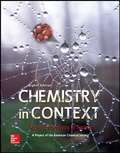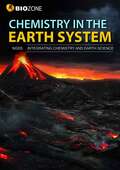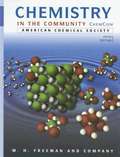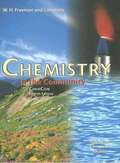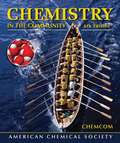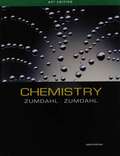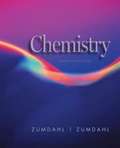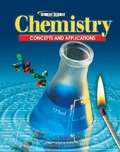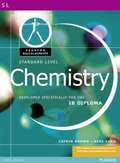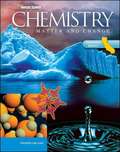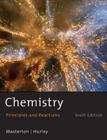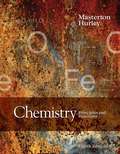- Table View
- List View
Chemistry in The Earth System: Integrating Chemistry and Earth Science, NGSS
by Tracey Greenwood Kent Pryor Lissa Bainbridge-SmithNIMAC-sourced textbook
Chemistry in the Community
by American Chemical Society"Chemistry in the Community is a post-secondary chemistry course structured around applied community issues related to chemistry rather than around specific chemical concepts. Concepts are presented on a ""need-to-know"" basis, allowing students to experience chemistry on first hand. The course is about 50% laboratory-based, and features activities where students must apply their chemistry knowledge to realistic decision-making situations."
Chemistry in the Community
by American Chemical Society"Chemistry in the Community is a post-secondary chemistry course structured around applied community issues related to chemistry rather than around specific chemical concepts. Concepts are presented on a ""need-to-know"" basis, allowing students to experience chemistry on first hand. The course is about 50% laboratory-based, and features activities where students must apply their chemistry knowledge to realistic decision-making situations."
Chemistry in the Community (4th Edition)
by American Chemical SocietyChemistry in the Community (ChemCom) is a year-long high school chemistry course for college-bound students, structured around community issues related to chemistry. The course is about 50% laboratory-based, and features decision-making activities which give students practice in applying their chemistry knowledge in realistic decision-making situations. Concepts are presented on a "need-to-know" basis, allowing students to experience the use and application of their chemistry learning, leading to a greater sense of motivation and a feeling of ownership of their new knowledge. Because of the nature of the issues covered in the specific units, students learn more organic and biochemistry than in traditional courses, as well as some environmental and industrial chemistry.
Chemistry in the Community: Chemcom
by American Chemistry SocietyNIMAC-sourced textbook <P><P>Touted as the most successful NSF-funded project published, Chemistry in the Community (ChemCom) by the American Chemical Society (ACS) offers a meaningful and memorable chemistry program for all levels of high school students. ChemCom covers traditional chemistry topics within the context of societal issues and real-world scenarios. Centered on decision-making activities where students are responsible for generating data in an investigating, analyzing that data and then applying their chemistry knowledge to solve the presented problem. The text is intensively laboratory-based, with all 39 of the investigations integrated within the text, not separate from the reading. With the ChemCom program, students learn more organic and biochemistry, more environmental and industrial chemistry, and more on the particulate nature of matter than other textbooks all within the relevance of solving problems that arise in everyday life. <P><P>Meticulously updated to meet the needs of today's teachers and students, the new sixth edition of ChemCom adheres to the new science framework as well as the forthcoming next generation of science standards. Incorporating advances in learning and cognitive sciences, ChemCom’s wide-ranging coverage builds upon the concepts and principles found in the National Science Education Standards. Correlations are available showing how closely aligned ChemCom is to these and other state standards
Chemistry, AP* Edition
by Steven S. Zumdahl Susan A. ZumdahlThis fully updated Ninth Edition of Steven and Susan Zumdahl's CHEMISTRY brings together the solid pedagogy, easy-to-use media, and interactive exercises that today's instructors need for their general chemistry course. Rather than focusing on rote memorization, CHEMISTRY uses a thoughtful approach built on problem-solving. For the Ninth Edition, the authors have added a new emphasis on critical systematic problem solving, new critical thinking questions, and new computer-based interactive examples to help students learn how to approach and solve chemical problems--to learn to think like chemists--so that they can apply the process of problem solving to all aspects of their lives. Students are provided with the tools to become critical thinkers: to ask questions, to apply rules and develop models, and to evaluate the outcome. In addition, Steven and Susan Zumdahl crafted ChemWork, an online program included in OWL Online Web Learning to support their approach, much as an instructor would offer support during office hours. ChemWork is just one of many study aids available with CHEMISTRY that supports the hallmarks of the textbook--a strong emphasis on models, real world applications, visual learning, and independent problem solving. Available with InfoTrac Student Collections http://gocengage. com/infotrac.
Chemistry, AP* Edition
by Steven S. Zumdahl Susan A. ZumdahlThis fully updated Ninth Edition of Steven and Susan Zumdahl's CHEMISTRY brings together the solid pedagogy, easy-to-use media, and interactive exercises that today's instructors need for their general chemistry course. Rather than focusing on rote memorization, CHEMISTRY uses a thoughtful approach built on problem-solving. For the Ninth Edition, the authors have added a new emphasis on critical systematic problem solving, new critical thinking questions, and new computer-based interactive examples to help students learn how to approach and solve chemical problems--to learn to think like chemists--so that they can apply the process of problem solving to all aspects of their lives. Students are provided with the tools to become critical thinkers: to ask questions, to apply rules and develop models, and to evaluate the outcome. In addition, Steven and Susan Zumdahl crafted ChemWork, an online program included in OWL Online Web Learning to support their approach, much as an instructor would offer support during office hours. ChemWork is just one of many study aids available with CHEMISTRY that supports the hallmarks of the textbook--a strong emphasis on models, real world applications, visual learning, and independent problem solving. Available with InfoTrac Student Collections http://gocengage. com/infotrac.
Chemistry, Study Guide
by Paul B. KelterReflects the unique problem-solving approach of the book. Includes alternate problem solving strategies, supplemental explanations, summaries of chapter sections, 400 worked examples, 800 self-practice tests, and answers to the exercises and self-tests--all designed to help students master the text material.
Chemistry: A Contemporary Approach
by Paul S. Cohen Paul S. GeffnerThis book is designed to make learning easier for students. Its content is carefully selected and logically organized. It offers a shortened introductory chemistry course.
Chemistry: A Molecular Approach (AP Edition)
by Nivaldo J. TroA student oriented book that provides relevant information that will motivate and get them to achieve the highest possible level in chemistry.
Chemistry: Concepts And Applications
by Mcgraw-Hill StaffChemistry: Concepts and Applications is a conceptual approach to the presentation of chemistry. It has a clear and comprehensive narrative of chemistry concepts with just the right amount of math. Two of many in-text lab options include Launch Labs and Try at Home Labs, the latter of which are unique to Glencoe. The program's media/technology support diverse classroom instruction.
Chemistry: Concepts and Applications
by Cheryl Wistrom John S. Phillips Victor S. StrozakChemistry: Concepts and Applications is a conceptual approach to the presentation of chemistry. It has a clear and comprehensive narrative of chemistry concepts with just the right amount of math.
Chemistry: Concepts and Applications
by Mcgraw-Hill StaffChemistry: Concepts and Applications is a conceptual approach to the presentation of chemistry. It has a clear and comprehensive narrative of chemistry concepts with just the right amount of math. Two of many in-text lab options include Launch Labs and Try at Home Labs, the latter of which are unique to Glencoe. The program's media/technology support diverse classroom instruction.
Chemistry: Developed Specifically for the IB Diploma
by Mike Ford Catrin BrownThis book is designed to act as a comprehensive course book, covering both the core material and all the options you might take while studying for the IB Diploma in Chemistry at Standard Level. It will also help you to prepare for your examinations in a thorough and methodical way.
Chemistry: Matter and Change
by Laurel Dingrando Nicholas Hainen Kathleen TallmanMeets All California State Standards!Glencoe CaliforniaChemistry: Matter and Changecombines the elements students need to succeed! A comprehensive course of study designed for a first-year high school chemistry curriculum, this program incorporates features for strong math support and problem-solving development. Promote strong inquiry learning with a variety of in-text lab options, including Discovery Labs, MiniLabs, Problem-Solving Labs, and ChemLabs (large- and small-scale), in addition to Forensics, Probeware, Small-Scale, and Lab Manuals. Provide simple, inexpensive, safe chemistry activities with Try at Home labs. Unique to Glencoe, these labs are safe enough to be completed outside the classroom and are referenced in the appropriate chapters!
Chemistry: Matter and Change (Alabama)
by Laurel Dingrando Nicholas Hainen Cheryl Wistrom Dinah Zike Thandi ButheleziNIMAC-sourced textbook
Chemistry: Matter and Change (Oklahoma)
by Thandi Buthelezi Laurel Dingrando Nicholas HainenChemistry: Matter and Change is a comprehensive chemistry course of study, designed to for a first year high school chemistry curriculum. The program incorporates features for strong math support and problem-solving development. The content for the 2005 revision has been reviewed for accuracy. This program offers new “Try At Home” labs in the student edition. A new Science Notebook ancillary has been developed to assist students, lesson-by-lesson, in comprehending the main idea. Significant enhancements have been made to the program’s technology support.
Chemistry: Matter and Change, Solving Problems, Chemistry Handbook
by McGraw-HillNIMAC-sourced textbook
Chemistry: Principles and Reactions
by Cecile N. Hurley William L. MastertonThis textbook outlines the principles that govern chemical reactions and continuously illustrates their usefulness in practical applications. The authors (University of Connecticut) cover reactions in aqueous solutions, the ideal gas law, electron arrangements, rate of reaction, acid-base solutions, and complex ions. The sixth edition replaces 30% of the in-text examples, adds four research essays, and updates molecular models. Annotation ©2008 Book News, Inc., Portland, OR (booknews.com)
Chemistry: Principles and Reactions
by Cecile N. Hurley William L. MastertonDiscover all of the fundamental topics of general chemistry with this brief, reader-oriented book. CHEMISTRY: PRINCIPLES AND REACTIONS, 8e, provides a clear, concise presentation based on the authors' more than 50 years of combined teaching experience. The book includes graded and concept-driven examples as well as examples that focus on molecular reasoning and understanding, as well as "Chemistry: Beyond the Classroom" essays that demonstrate the relevance of the concepts and highlight some of the most up-to-date uses of chemistry. A strong, enhanced art program helps readers visualize chemical concepts. Integrated end-of-chapter questions and Key Concepts correlate to OWLv2, the #1 online homework and tutorial system for chemistry.
Chemistry: The Molecular Nature of Matter and Change
by Martin S. SilberbergWith each edition,Chemistry: The Molecular Nature of Matter and Changeby Martin Silberberg is becoming a favorite among faculty and students. Silberberg's 5th edition contains features that make it the most comprehensive and relevant text for any student enrolled in a general chemistry course. The text contains unprecedented macroscopic to microscopic molecular illustrations, consistent step-by-step worked exercises in every chapter, and an extensive range of end-of-chapter problems which provide engaging applications covering a wide variety of freshman interests, including engineering, medicine, materials, and environmental studies. All of these qualities makeChemistry: The Molecular Nature of Matter and Changethe centerpiece for any General Chemistry course.
